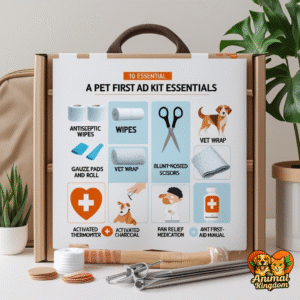
Pet First Aid Kit Essentials: A Comprehensive Guide to Emergency Preparedness
Understanding the Importance of a Pet First Aid Kit
Pet owners often overlook the critical necessity of assembling a first aid kit specifically for their pets. Just like humans, animals can encounter emergencies that may require immediate attention. Having a well-stocked pet first aid kit on hand can significantly affect the health and safety of pets during such situations. The unpredictability of life means accidents can happen at any time, and being prepared can make all the difference in ensuring a positive outcome.
Common emergencies that pets might face include injuries such as cuts, scrapes, or bites from other animals. These types of wounds can vary from minor to severe, and having the right supplies can help stabilize a pet’s condition before they receive professional veterinary care. Allergic reactions, which can arise from insect bites, food ingredients, or environmental factors, are another situation where having a pet first aid kit becomes essential. Knowing how to respond quickly can alleviate a pet’s distress and potentially save their life.
Additionally, pets can encounter other urgent issues, including choking, poisoning, or heatstroke. For example, if a pet unknowingly ingests a toxic substance, quick access to specific antidotes or instruction sheets in a first aid kit can help mitigate the effects of the poison until veterinary professional assistance is available. Moreover, heatstroke, particularly in hot weather, requires prompt intervention, and familiarity with first aid techniques can be lifesaving
In essence, pet first aid kits are not just for serious emergencies; they provide pivotal support for minor issues as well. Equipping oneself with essential tools fosters confidence in addressing potential risks that our beloved pets may encounter. By prioritizing the creation of a comprehensive first aid kit, pet owners demonstrate commitment to their pets’ well-being, ensuring they are prepared for any unforeseen circumstances.
Essential Items for Your Pet First Aid Kit
First and foremost, bandages are crucial in managing bleeding and protecting wounds. Elastic bandages or self-adhesive wraps are particularly useful, as they can be applied without sticking to the fur. Antiseptic wipes or solutions, such as hydrogen peroxide (not recommended for open wounds) and saline solution, can help clean injuries and prevent infections.
Gauze pads and rolls should also be included for dressing wounds. These are instrumental in absorbing blood and providing a protective barrier. Additionally, a pair of scissors will assist in cutting tape, gauze, or clothing if necessary. To handle injury situations effectively, pet owners should include a pair of nitrile gloves to maintain hygiene while treating their pets.
A pet muzzle is another essential item. While it may be necessary to restrain an injured animal to prevent further harm, it is essential to ensure that the muzzle is appropriately fitted to your pet’s size. Furthermore, a splint can be beneficial for stabilizing a fracture or injury until professional help is available. Together, these items offer immediate support in emergencies.
Lastly, it’s advisable to include a digital thermometer specifically designed for pets, as pets often exhibit signs of illness that may not be readily visible. Having a comprehensive first aid manual can also be invaluable for pet owners in emergencies, offering instructions on how to address various situations effectively. Preparing your pet first aid kit with these essential items ensures you’re ready to provide immediate care when unexpected situations arise.
How to Assemble Your Pet First Aid Kit
Creating a well-stocked pet first aid kit is a critical step in ensuring your furry friend’s safety and well-being during emergencies. The first step in assembling your kit is to select an appropriate container. A sturdy, waterproof box or a dedicated backpack is ideal as it will protect the contents from moisture while allowing for easy portability. Consider choosing a container that is clearly labeled, which will facilitate quick access in urgent situations.
Once you have your container, the next step is to gather essential supplies. Start by including basic items such as sterile gauze pads, adhesive tape, scissors, tweezers, and a digital thermometer. Additionally, incorporate a variety of bandages and antiseptic wipes to treat minor wounds. It is also prudent to include a pet-specific first aid manual, as this will provide valuable guidance during emergencies. Don’t forget to add your pet’s medical records and any current medications, as these can be crucial during veterinary visits.
Organizing the supplies within your first aid kit is equally important. Group similar items together to facilitate quick access when needed. For example, keep all wound care materials in one section and medication in another. You may also choose to have a small bag for travel that includes essential items that can fit conveniently in your pet’s carrier. Tailor the kit further by considering your pet’s specific needs; for instance, if your pet has allergies, be sure to include an antihistamine approved by your veterinarian.
Regular maintenance of your pet first aid kit is vital. It is recommended to check the contents every few months to replace expired medications and restock used supplies. Keeping your kit updated ensures that you are always prepared to provide prompt care in case of an emergency, allowing for peace of mind as you nurture your beloved companion
Emergency Response Tips for Pet Owners
Being prepared for emergencies involves understanding how to respond effectively when a situation arises involving your pet. First and foremost, it is crucial to assess your pet’s condition accurately. Observe any visible signs of distress, such as difficulty breathing, excessive bleeding, or lethargy. Gauge the severity of the situation to determine the appropriate course of action. When assessing your pet, remain calm; your demeanor influences their response and helps prevent further agitation.
In case of minor injuries, there are basic first aid techniques that pet owners can employ. These include cleaning wounds with mild antiseptics, applying light pressure to control bleeding, and immobilizing a limb if suspected fractures are present. Always keep a pet first aid kit on hand, which should include essentials like bandages, gauze, adhesive tape, antiseptic wipes, and tweezers. Familiarizing yourself with these items before an emergency occurs ensures you can act swiftly and efficiently.
However, some situations necessitate professional intervention. If your pet’s condition appears severe or if their behavior is drastically altered, it is essential to seek veterinary help immediately. Knowing when to contact your veterinarian or an animal emergency clinic is key to ensuring your pet receives timely care.
While emergencies can be chaotic, maintaining a level-headed approach is crucial. Take deep breaths and remember your safety and that of your pet are paramount. Additionally, consider enrolling in pet first aid and CPR courses for further knowledge. Resources such as instructional videos, brochures from veterinarians, and workshops can equip you with invaluable skills for effective emergency preparedness. Remaining informed and proactive will help ensure that you can confidently respond to your pet’s needs in a crisis, ensuring their safety and well-being.

